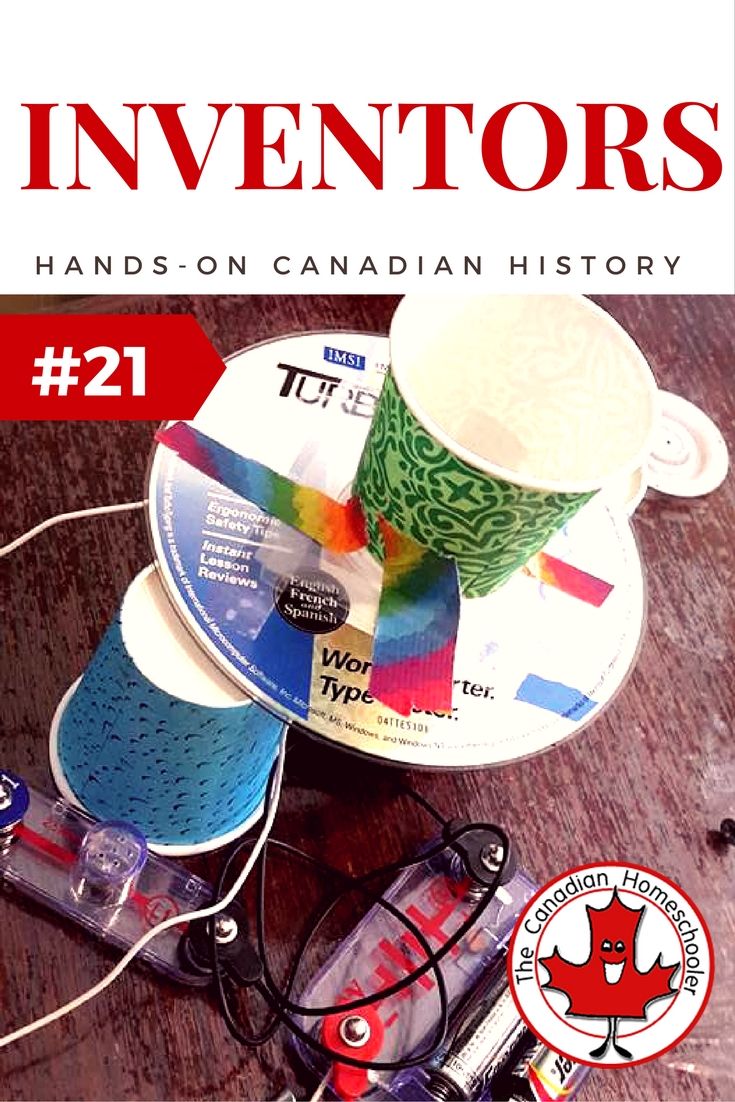Canada’s history includes some amazing inventors, such as Frederick Banting who discovered the connection between insulin and diabetes, and Alexander Graham Bell who patented the telephone.

Make a Model Liquid Transmitter
Mr. Bell’s invention involved using sound waves to complete an electrical circuit. Using a cone to amplify the sound causes a membrane to vibrate, which moves a pin up and down into liquid. Connected to a battery and an output device, one side of the wire attaches to that pin, and the other to the container of liquid allowing the circuit to be complete. Now it’s your turn to be one of the great inventors. Try making a model of Mr. Bell’s early telephone.
I will premise this project with an admission that no matter how hard we tried, and no matter what alterations we made, we could NOT get the circuit to work through liquid to work (even without the added extra of using a pin.) The circuit worked great on its own, but not with the liquid. We tried tap water, vinegar, and even lemon juice. Maybe our battery wasn’t strong enough? Maybe we needed to use a different level of liquid? Maybe we just missed 1 important step? Our challenge for you is to try this experiment and let us know what we did wrong! Despite the fact it didn’t work for us, we actually learned a lot about how Mr. Bell’s design functioned, and even just being able to feel the vibrations of the pin when we put it gently on our finger while speaking into the cone was pretty neat. Here’s what we did.
Materials Needed
- An old CD
- a small pin
- tape
- dixie cup
- scissors
- small piece of the bag inside a cereal or cracker box
- a battery (maybe 9V? We tried 2 AA batteries.)
- wires
- LED light
- water or vinegar (or other conductive liquid)
- Small cup for liquid (such as the metal tin from a tealight candle)
Step 1. Make a circuit.
Create a circuit with the wires, attaching a battery and an LED light. Make sure that the light turns on when the circuit is complete. Now test the addition of a liquid to your circuit. Fill your container with whatever conductive liquid you are going to use. Put one wire into it and one going out of it. Make sure the wires don’t touch each other or the container. Does the light work now?
Step 2. Create the device.
Tape a small piece of the bag from a cereal or cracker box tightly across the hole in the middle of the CD. Push a pin through it so that the head touches the membrane. Cut the bottom off a dixie cup and tape above the whole to create a cone. Do a test so feel how things vibrate when you speak into the cone. Take of the wires that you had in the liquid on the last step and attach it to the pin carefully. That way, it will be part of the circuit on the next step.
Step 3. Connect the two.
Now comes the tricky part. You need to create a way to hold your device up above the container of liquid so the pin is JUST above the liquid without touching it. That way, when the pin vibrates it will dip into the liquid and complete the circuit. When it is all set up, speak into the cone to make the pin vibrate. Can you see the light work?
If you get it to work, make sure you tell us! Or post a picture on our facebook page or send us an email!
Need a different invention to try out? Here is a great list of all the amazing things Canadians have invented.
See all 31 Days of Hands-on Canadian History.
- How to Keep a Toddler Busy While Homeschooling - March 21, 2024
- 25+ Things Your Kids Learn From Video Games - March 20, 2024
- 10 Words For New Homeschoolers - March 20, 2024


